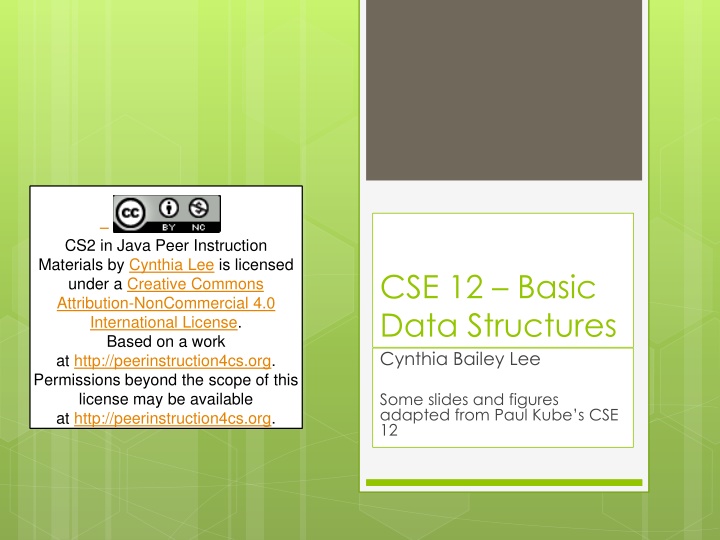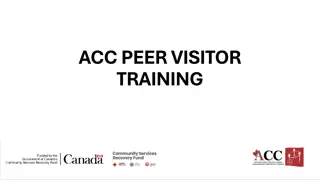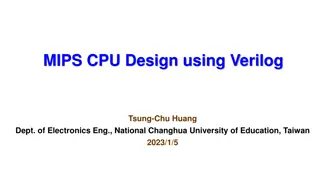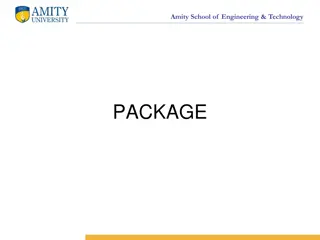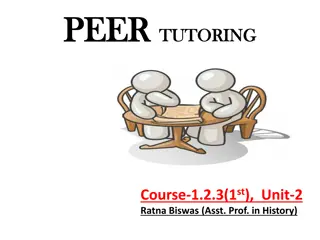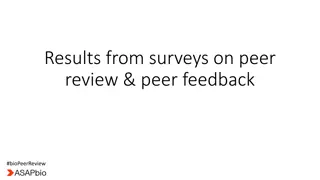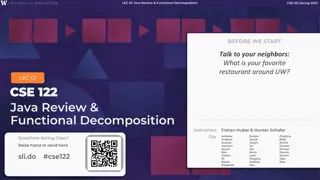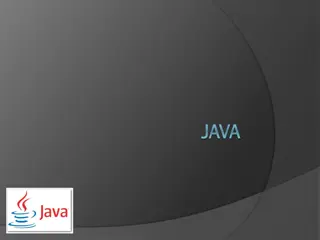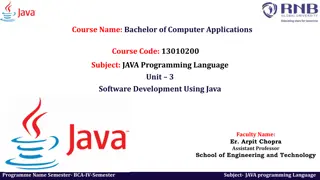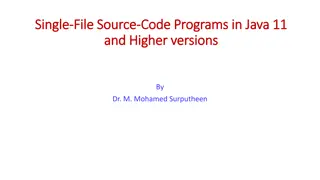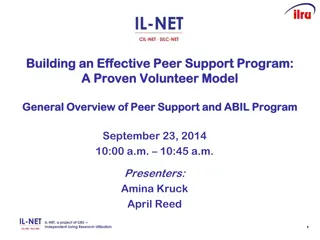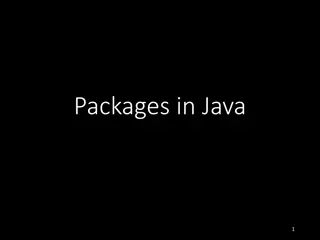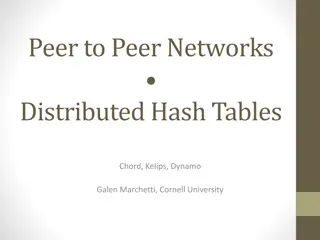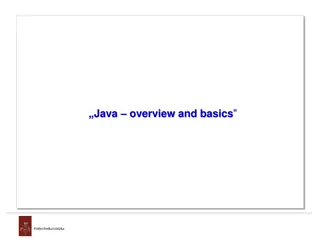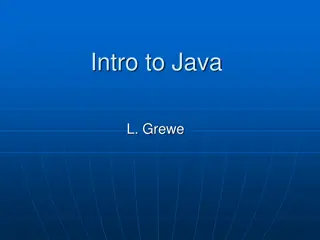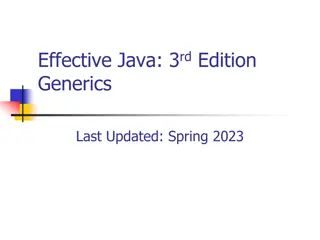Peer Instruction in Java: Enhancing Learning Experience
Explore the world of data structures through peer instruction in Java with Cynthia Lee. This approach involves interactive group discussions, problem-solving, and hands-on activities to deepen understanding of key concepts. The course covers topics such as ADTs, APIs, algorithm analysis, object-oriented design, software testing, and Java collections. Embrace the power of abstraction and delve into various data structures like trees, heaps, and hash tables. Enhance your coding skills and collaborate effectively with your peers in a dynamic learning environment.
Download Presentation

Please find below an Image/Link to download the presentation.
The content on the website is provided AS IS for your information and personal use only. It may not be sold, licensed, or shared on other websites without obtaining consent from the author.If you encounter any issues during the download, it is possible that the publisher has removed the file from their server.
You are allowed to download the files provided on this website for personal or commercial use, subject to the condition that they are used lawfully. All files are the property of their respective owners.
The content on the website is provided AS IS for your information and personal use only. It may not be sold, licensed, or shared on other websites without obtaining consent from the author.
E N D
Presentation Transcript
Creative Commons License CS2 in Java Peer Instruction Materials by Cynthia Lee is licensed under a Creative Commons Attribution-NonCommercial 4.0 International License. Based on a work at http://peerinstruction4cs.org. Permissions beyond the scope of this license may be available at http://peerinstruction4cs.org. CSE 12 Basic Data Structures Cynthia Bailey Lee Some slides and figures adapted from Paul Kube s CSE 12
2 What do I do in class? Think of me as your tutor Be your guide in inducing you to explore concepts Create situations and pose problems that set the scene for yourexploration Answer your questions Notspend lecture reading the textbook to you with slightly different words
3 What do you do in class? (before class, you prepared yourself by reading; a reading quiz at the beginning of class will check your preparation) 1. I ask a question 2. You first answer it by yourself 3. Then discuss in assigned groups of 3-4 students Like a jury, you must come to a unanimous decision Answer the question a second time 4. I will ask groups to share their insights, and I will provide additional clarification as needed
4 Tips for a good group discussion Take turns being the first one to talk Once you all agree on the answer, don t stop! Always go over each wrong answer and explain why it is wrong Also interesting and useful to think about why somebody might be tempted to choose it how was Prof. Lovett hoping to trick somebody by including that wrong answer? Even if your group-mate has said something very clearly and correctly, it s a good idea to repeat it yourself So, what I think you said was, Might seem pointless, but your brain will remember better if YOU say it too
Data Structures Map of the course
Course topics Abstraction and Abstract Data Types (ADTs) Application Programmer Interfaces (APIs) Algorithm Time, Space, and Energy Cost Analysis Object-oriented Software Design Patterns, including Inheritance, Composition, Adapter, and Iterator Software Testing and the JUnit framework Java Classes and Interfaces Collections, and the Java Collections Framework Java Generics Arrays, Stacks, Queues, Circular Arrays Searching and Sorting Algorithms Trees, Heaps, Binary Search Trees, Abstract Syntax Trees Hashing and Hash Tables
7 Abstraction o Abstraction means: o Hiding irrelevant details to focus on the essential features needed to understand and use a thing o Abstraction is an essential tool for managing complexity o Designing, implementing, and using complex systems would be impossible without abstraction
Group discussion What is another good daily life example of abstraction? Maybe I can use yours next quarter instead!
9 One kind of abstraction in Computer Science: Data Types o Specifying an Abstract Data Type ADT) requires specifying two things: o Possible values for instances of the type o Operations that can be performed on those instances o Does NOT require specifying: o How are those values and operations implemented?
10 ADT Implementers and Users This kind of abstraction is very powerful. The ADT can be implemented without having to know details of how it will be used (except that it will be used in accordance with its interface specification) The ADT can be used without having to know the details of how it is implemented (except that it was implemented to satisfy its interface specification) With any specification of an ADT interface: The ADT can be used infinitely many ways, and The ADT can be implemented infinitely many ways! This makes designing, implementing, using and maintaining software easier and more flexible
11 Example: a String ADT You might define a String abstract data type along these lines: Values: a String is a sequence of zero or more Unicode 1.0 characters Operations: Create a String Add a character to the end of a String Say what character is at a particular position in a String What other operations might be good to specify for a String ADT?
12 ADTs are language-neutral In CSE 12 we will concentrate on implementing ADT s in Java And we will consider many features of Java that are useful for implementing ADT s But always keep in mind that the basic principles of ADT design and analysis are language-neutral! APIs are like ADTs, but specify the interface in a particular language Users and impelmenters still do things as they please, but both within a common language
13 Application Programmer Interface (API) The implementer of an ADT in a particular language is a programmer And, usually, the client or user of an ADT is also a programmer in that language, who wants to use the ADT as a component in a larger software application Therefore the interface to an ADT in a particular language is said to be the Application Programmer Interface, or API, for the ADT in that language
14 Checkpoint: ADTs and APIs Which of the following would be elements of an ADT specification, and which would be elements of an API specification? I. int getValueAtIndex(int index) throws IndexOutOfBoundsException II. Get operation: given an index, returns the value at that index A. I is part of an API and II is part of an ADT B. II is part of an API and I is part of an ADT C. Both I and II could be part of an API or ADT D. Other
Discussion ADTs and APIs exist to prevent users from knowing the implementation details (and vice versa). But Are there times when it would be useful to know the implementation details of an ADTs operations or values? Why?
16 Next time Abstraction, continued The Inheritance and Composition Patterns Intro to UML Intro to the Java Collections Framework (JCF) Intro to Unit Testing with JUnit Reading: Gray, Ch 1 and Ch 2
17 Thought of the Week To be a good geek you have to have both humility and arrogance in equal measures. The humility is so you ll admit you don t know something and get help/read the docs/etc. The arrogance is the bit that says I don t know that now but I can and I will soon. --Thomas Beagle, IT/programmer
Abstraction by interface public interface List insert(element) remove(element) find(element) isEmpty() The Application Programmer Interface (API) of List specifies everything an application programmer (client, user) needs to know in order to use a List.
Same interface, different uses Any client (user) can make use of a List through its public Application Programmer Interface (API) without knowledge of how the List is implemented.
Same interface, different implementations There are many possible implementations of any ADT. The implementation details are hidden from the user of the ADT, who can rely just on the ADT s API.
21 User-defined data types in Java Java has 8 primitive types: byte, short, int, long, char, float, double, boolean And those are all there are: Java does not allow additional user-defined primitive types If you want to define a type in Java, you must define either an interface, or a class Often we will use both interfaces and classes when implementing an ADT in Java
22 ADT s and Java classes An ADT specifies the possible values that instances of the ADT can have, and the operations that can be performed on them A Java class defines instance variables, and instance methods So, there is a very close relationship between an ADT and a class! Variables defined in the class correspond to ADT values Methods defined in the class correspond to ADT operations
23 ADT s and Java interfaces Usually, instance variables should be private in a class They are considered part of the implementation, not to be accessed directly from outside the class Then, we write public instance methods to manipulate the instance variables Mutator methods change the values of instance variables; Accessormethods just read out the values This permits precise control over how the instance variables can be accessed and changed So, the principle of abstraction suggests we can concentrate on the public instance methods Java interfaces do that: they define a Java type, but specify only public instance method signatures (no method bodies, no instance variables)
